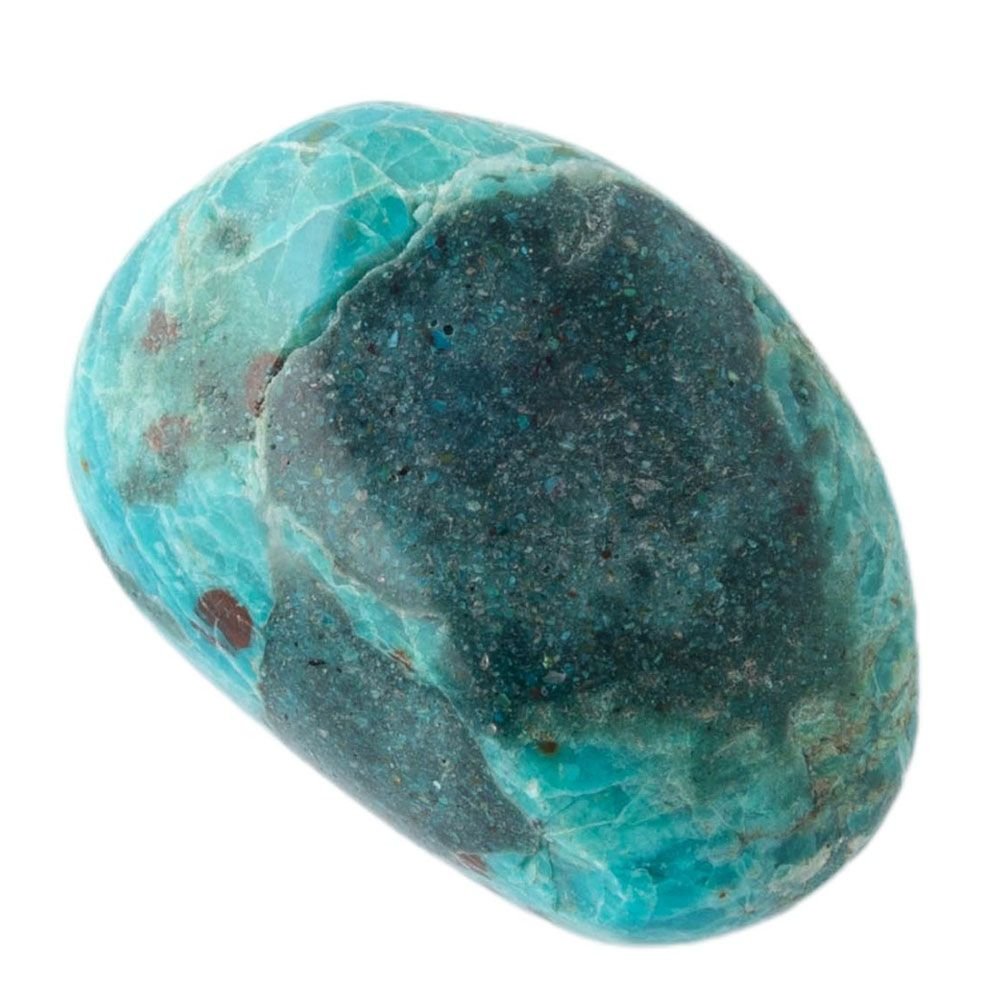
Chrysocolla derives its name from the Greek words chrysos (gold) and kolla (glue), referring to its historical use as a flux in soldering gold. The name was first coined by the ancient Greek philosopher Theophrastus around 315 BCE. Throughout history, it has also been known as “Eilat Stone” (when found mixed with other copper minerals in Israel) and “Gem Silica” (a high-quality translucent variety). Some cultures have referred to it simply as “Copper Lapis” due to its rich blue-green hues.
Composition and Physical Characteristics
Chrysocolla is a hydrous copper silicate mineral with the chemical formula (Cu,Al)₂H₂Si₂O₅(OH)₄·nH₂O. It is often found in botryoidal, fibrous, or massive forms rather than as distinct crystals. Chrysocolla is relatively soft, with a Mohs hardness of 2 to 4, but when intergrown with quartz, it can become much harder. Its colours range from vibrant turquoise and deep blues to rich greens, often creating stunning patterns resembling ocean waves or verdant landscapes. It has a vitreous to dull luster and is often mistaken for turquoise or malachite due to its similar hues.
Varieties of Chrysocolla
- Pure Chrysocolla – Soft and fragile, often found in botryoidal masses.
- Gem Silica (Chrysocolla Chalcedony) – A rare and highly sought-after variety where chrysocolla is infused with quartz, making it more durable and translucent.
- Eilat Stone – A mix of chrysocolla, malachite, turquoise, and azurite found in Israel.
- Chrysocolla with Quartz – A tougher variety where quartz strengthens the softer chrysocolla structure.
Locations and Significant Finds
Chrysocolla is primarily found in copper deposits worldwide. Some of the most notable sources include:
- United States – Arizona (notably the Globe-Miami and Morenci mines) produces high-quality material.
- Peru – Known for its intensely vibrant blue and green specimens.
- Democratic Republic of the Congo – Supplies rich, bright blue chrysocolla.
- Israel – The legendary Eilat Stone is sourced from ancient copper mines.
- Mexico, Russia, Australia, and Namibia also yield significant deposits.
Archaeological and Historical Usage
Ancient civilisations, including the Egyptians, Greeks, and Native American tribes, prized chrysocolla for its striking colour and metaphysical properties. It was often ground into a fine powder for use as a pigment in art and cosmetics. The Incas and Aztecs used it in jewellery and carvings, believing it had protective qualities. In Ancient Egypt, it was associated with wisdom and was often worn by rulers and scholars.
Current Usage
Today, chrysocolla remains popular in jewellery, often cut into cabochons, beads, and carvings. Gem silica, the highest-quality chrysocolla variety, is particularly valued in fine jewellery. It is also used in decorative objects and energy healing practices due to its perceived calming and communicative properties.
Interesting Facts
- The gemstone is often mistaken for turquoise due to its similar appearance but is softer and more delicate unless combined with quartz.
- Chrysocolla has been found in paintings and murals dating back to ancient Egypt, showcasing its historical use as a pigment.
- Some specimens fluoresce under UV light due to traces of certain minerals.
Folklore, Legends, and Tales
- The Wisdom Stone: Ancient Egyptian lore suggests that Cleopatra carried chrysocolla as a talisman to enhance her diplomatic skills and wisdom.
- The Speaker’s Stone: In Native American traditions, it was believed that chrysocolla could grant eloquence and was used by orators and leaders.
- The Peacemaker’s Jewel: Some medieval European legends say that chrysocolla could bring harmony and was often worn by those seeking to resolve disputes.
Astrology and Zodiac Links
Chrysocolla is primarily associated with Taurus, Gemini, and Virgo. It is said to enhance communication for Geminis, bring stability to Taureans, and help Virgos express their emotions more freely. It is also sometimes linked to Sagittarius, aiding in wisdom and exploration.
Chakra System Connections
This stone is deeply connected to the throat chakra, enhancing communication, truth, and self-expression. It also resonates with the heart chakra, promoting compassion, inner peace, and emotional balance. Some believe it has minor influences on the third eye chakra, helping with intuition and spiritual insight.
Birthstone and Wedding Anniversary Links
While not a traditional birthstone, chrysocolla is often associated with those born in March and December, aligning with the energies of Pisces and Sagittarius. It is sometimes gifted as an alternative to turquoise for the 11th wedding anniversary, symbolising wisdom, understanding, and enduring love.
